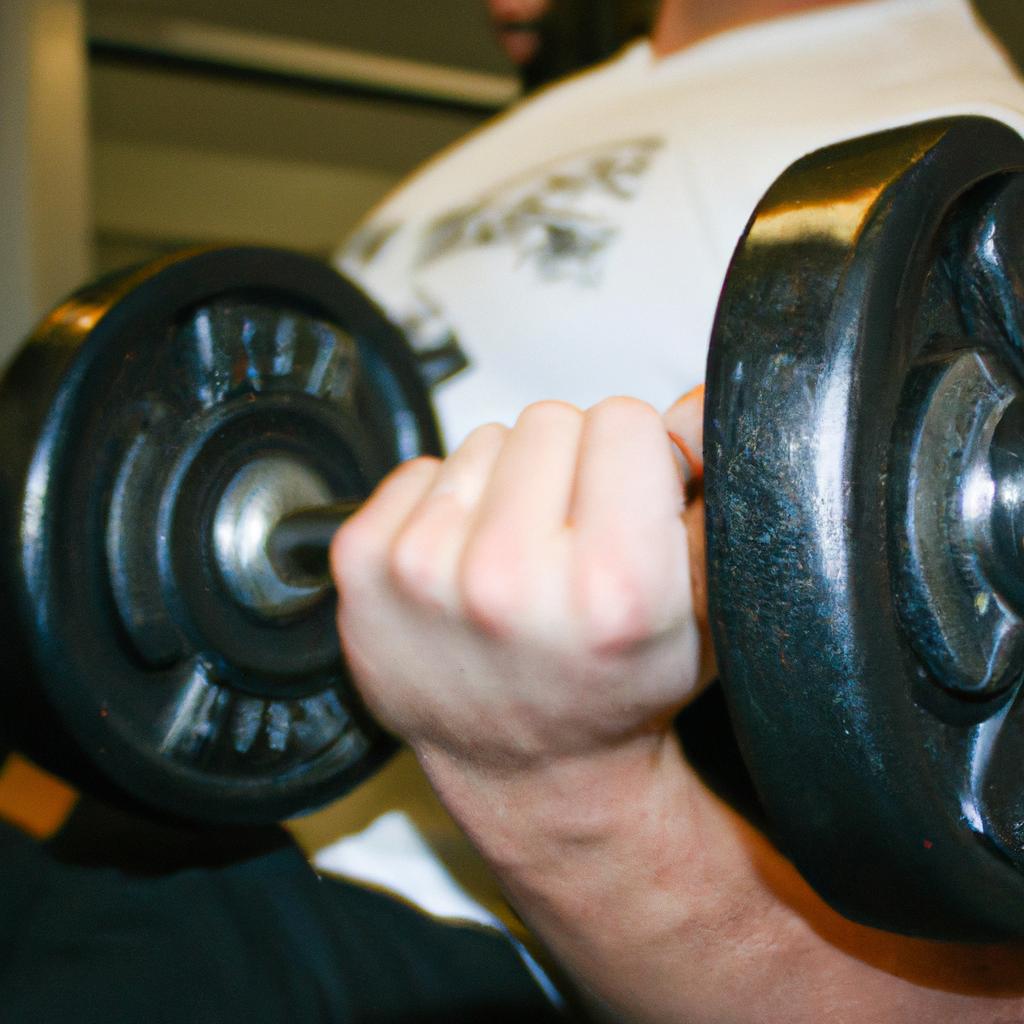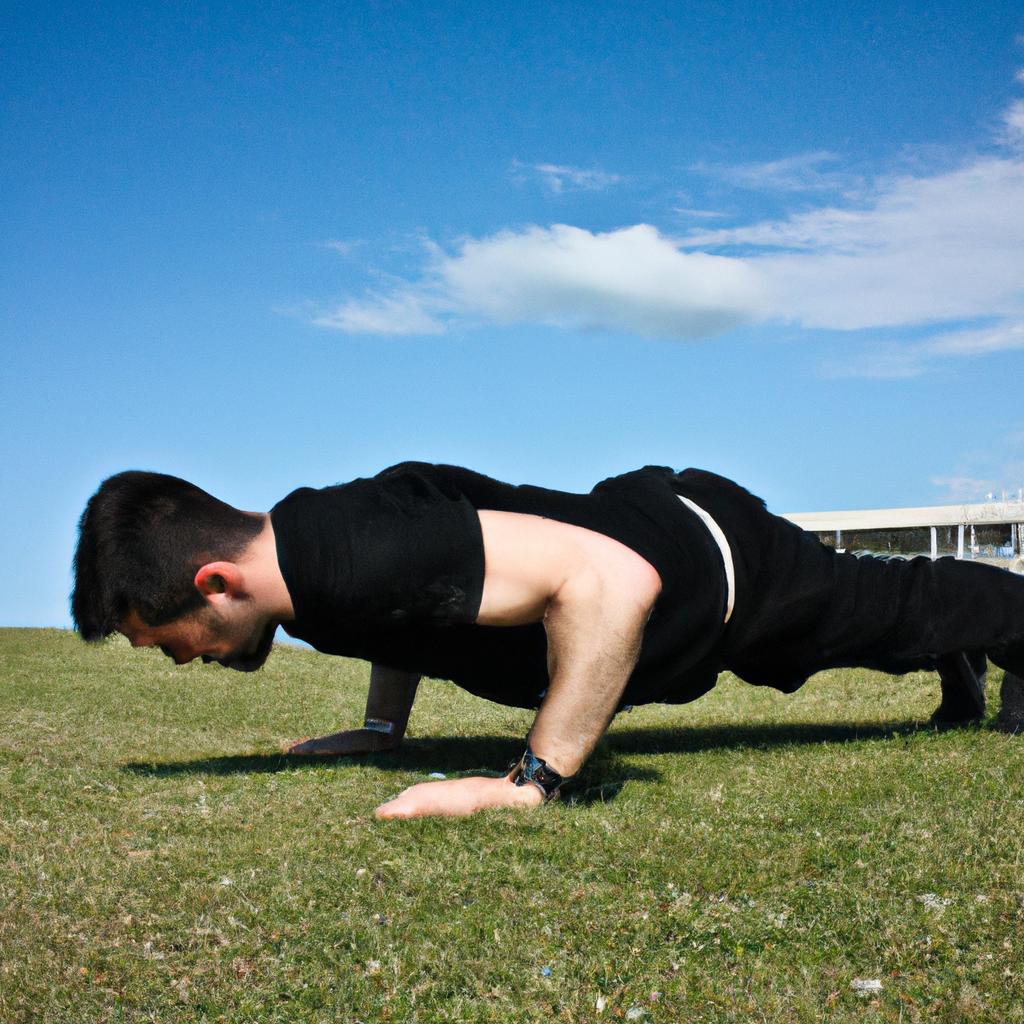Plyometrics, also known as jump training or plyos, is a form of exercise that has gained popularity in the fitness community for its ability to enhance strength and power. This article aims to explore the benefits of incorporating plyometric exercises into one’s fitness routine, focusing on their effectiveness within the context of a fitness studio setting. To better illustrate this concept, consider the case study of Sarah, an avid gym-goer who started including plyometrics in her workouts. Through consistent practice and guidance from her trainer, she experienced significant improvements in her overall strength and athletic performance.
The use of plyometrics involves explosive movements that engage multiple muscle groups simultaneously. By utilizing rapid stretching and contracting motions, these exercises help train the muscles to generate maximum force in a short amount of time. The result is improved muscular power and efficiency, which can greatly benefit individuals looking to enhance their athletic abilities or simply improve their functional movement patterns. In addition to increasing strength, plyometrics have been shown to boost endurance levels by enhancing the body’s ability to store energy and utilize it efficiently during physical activity.
Understanding Plyometrics
Imagine a scenario where an athlete is struggling to improve their explosive power for sprinting. Despite hours of traditional strength training exercises, they are unable to achieve the desired results. This is where plyometrics comes into play – a specialized form of exercise that focuses on increasing power and speed through rapid muscle contractions.
To fully comprehend the benefits and principles behind plyometrics, it is crucial to understand its foundation. Plyometrics, also known as jump training or reactive training, involves quick and powerful movements that utilize both the stretch-shortening cycle of muscles and the elastic properties of tendons. By rapidly stretching a muscle (eccentric phase) followed by an immediate contraction (concentric phase), athletes can generate maximum force in minimal time.
To better grasp the concept of plyometrics, let’s explore some key elements:
- Explosive Movements: Plyometric exercises primarily involve explosive movements, such as jumps and bounds, which require high levels of force production in short periods.
- Neural Adaptations: These exercises target the nervous system, enhancing neural pathways responsible for fast-twitch muscle activation and coordination.
- Energy Storage and Release: The stretch-shortening cycle allows muscles to store energy during eccentric loading before releasing it during concentric contraction.
- Specificity: Plyometric training can be tailored to specific sports or activities, mimicking movement patterns relevant to each individual’s needs.
| Benefits of Plyometrics |
|---|
| Enhanced Power |
| Increased Speed |
| Improved Agility |
| Greater Vertical Jump |
Incorporating plyometric exercises into your fitness routine offers numerous advantages beyond simply boosting strength. In addition to increased power output and enhanced speed, individuals who engage in regular plyometric training may experience improved agility and a greater vertical jump height.
As we delve deeper into the fascinating realm of plyometrics, we will explore how this unique method can transform your athletic performance and take your fitness journey to new heights. So, let’s move forward and uncover the remarkable benefits of plyometrics.
Benefits of Plyometrics
Plyometrics, also known as jump training, is a form of exercise that focuses on explosive movements to boost strength and power. By incorporating rapid stretching and contracting of muscles, plyometric exercises improve muscular performance and enhance athletic abilities. To illustrate the effectiveness of this training method, let’s consider the case study of an aspiring athlete named Sarah.
Sarah was a track and field athlete looking to improve her sprinting speed. She incorporated plyometric exercises into her training routine, including box jumps, depth jumps, and medicine ball throws. Over time, she noticed significant improvements in her performance. Her sprint times decreased, her vertical jump increased by several inches, and she felt more explosive during competition.
The benefits of plyometrics extend beyond improved athletic performance. Here are some additional advantages:
- Increased muscle power: Plyometric exercises recruit fast-twitch muscle fibers, which are responsible for generating powerful movements.
- Enhanced coordination: The quick transitions between eccentric (lengthening) and concentric (shortening) muscle contractions improve neuromuscular coordination.
- Improved bone density: The high impact nature of plyometric exercises puts stress on bones, promoting bone growth and reducing the risk of osteoporosis.
- Efficient calorie burn: Due to their intense nature, plyometric workouts can help burn calories faster compared to traditional forms of exercise.
| Fitness Goal | Benefits |
|---|---|
| Strength | Increased muscle power |
| Speed | Enhanced explosiveness |
| Agility | Improved coordination |
| Weight loss | Efficient calorie burn |
Incorporating plyometrics into your fitness routine can yield numerous benefits across different fitness domains. Whether you’re aiming to build strength or lose weight, these explosive exercises offer a dynamic approach towards achieving your goals.
Now let’s delve deeper into specific plyometric exercises that can help you maximize your training potential: Key Plyometric Exercises.
Key Plyometric Exercises
In the previous section, we explored the numerous benefits that plyometric exercises offer. Now, let’s delve into some key plyometric exercises that can help you maximize your strength and power in the fitness studio. But first, let’s consider an example to illustrate how effective these exercises can be.
Imagine Sarah, a dedicated athlete aiming to improve her vertical jump for basketball. By incorporating plyometric training into her workout routine, she experienced significant improvements in her explosive power and overall athletic performance. This real-life case study demonstrates the potential impact of plyometrics on enhancing physical abilities.
Now, let’s outline several key plyometric exercises that can assist individuals like Sarah in reaching their fitness goals:
- Depth Jumps: These involve stepping off a box or platform and immediately exploding upward upon landing.
- Box Jumps: Jumping onto a high box from a standing position helps develop lower body strength and explosiveness.
- Medicine Ball Throws: Incorporating medicine ball throws with various movements such as overhead slams or chest passes engages multiple muscle groups while improving power output.
- Lateral Bounds: Performing side-to-side jumps over cones or hurdles enhances lateral stability and strengthens muscles involved in quick directional changes.
By incorporating these exercises into your fitness routine, you can expect to experience increased muscular strength, improved agility, enhanced speed, and greater power output.
To better understand the effectiveness of different plyometric exercises, refer to the following table which highlights specific muscle groups targeted by each exercise:
| Exercise | Primary Muscle Groups Targeted | Secondary Muscle Groups Targeted |
|---|---|---|
| Depth Jumps | Quadriceps, Hamstrings | Glutes |
| Box Jumps | Quadriceps | Calves |
| Medicine Ball Throws | Core Muscles | Pectorals |
| Lateral Bounds | Hip Abductors | Quadriceps, Hamstrings |
By incorporating a variety of plyometric exercises that target different muscle groups, you can create a well-rounded workout routine to optimize your strength and power gains.
As we move forward in our exploration of plyometrics, it is essential to consider safety considerations to minimize the risk of injury. Therefore, let’s now shift our focus to the next section on “Safety Considerations for Plyometrics” and explore important guidelines for performing these exercises effectively while safeguarding against potential harm.
Safety Considerations for Plyometrics
Imagine a fitness enthusiast named Sarah who has been struggling to improve her strength despite regular workouts. She decides to incorporate plyometric exercises into her fitness routine and is amazed by the results. This case study highlights how plyometrics can boost strength and enhance performance in the fitness studio.
Plyometric training involves explosive movements that utilize quick muscle contractions, aiming to increase power output and overall athleticism. By incorporating these exercises into your workout regimen, you can experience several benefits:
-
Improved muscular strength: Plyometrics engage both fast-twitch and slow-twitch muscle fibers, leading to increased overall strength. The rapid stretch-shortening cycle involved in plyometric movements helps develop stronger muscles over time.
-
Increased speed and agility: Plyometric exercises require sudden bursts of energy, which improves your ability to generate power quickly. This translates into enhanced speed and agility, allowing you to move faster and more efficiently during various activities or sports.
-
Enhanced coordination: The explosive nature of plyometrics demands precise timing and coordination between different muscle groups. Regular practice can significantly improve neuromuscular coordination, enabling smoother movement patterns and better control over body positioning.
-
Heightened calorie burn: Due to their high-intensity nature, plyometric exercises stimulate significant calorie expenditure during and after workouts. Incorporating these exercises into your routine can help maximize fat burning potential while promoting cardiovascular health.
To further understand the benefits of plyometrics, consider the following table:
| Benefit | Explanation |
|---|---|
| Improved Strength | Engages both fast-twitch and slow-twitch muscle fibers for increased overall strength |
| Increased Speed | Develops explosive power resulting in improved speed |
| Enhanced Coordination | Demands precise timing between muscles groups for better neuromuscular coordination |
| Heightened Calorie Burn | High intensity leads to significant caloric expenditure, aiding in fat loss and cardiovascular health |
Incorporating plyometrics into your workout routine can be a game-changer. By understanding the benefits they offer, you can make an informed decision about whether to include these exercises in your fitness regimen. The next section will provide guidance on how to effectively incorporate plyometric exercises into your workout routine for optimal results.
Incorporating Plyometrics into Your Workout Routine
Having understood the essential safety considerations for incorporating plyometrics into your workout routine, let us now explore how to effectively include this training method in your fitness regimen. By implementing these strategies, you can enhance your strength and overall performance in the gym.
To demonstrate the effectiveness of plyometric exercises, let’s consider a hypothetical case study involving an individual aiming to improve their vertical jump height. This person has been regularly performing resistance training but wants to further increase their explosive power. To achieve this goal, they decide to integrate plyometric exercises into their existing workout routine.
When incorporating plyometrics into your workouts, it is crucial to follow these guidelines:
- Gradually progress intensity: Start with low-intensity variations of plyometric exercises and gradually increase the difficulty over time. This progression allows your body to adapt and reduces the risk of injury.
- Choose appropriate surfaces: Perform plyometric movements on shock-absorbing surfaces like rubber or sprung floors to minimize joint stress and impact forces.
- Wear suitable footwear: Opt for athletic shoes that provide sufficient cushioning and support during high-impact activities. Proper footwear helps protect against foot and ankle injuries.
- Allow adequate recovery time: Plyometric training places significant stress on muscles and connective tissues. Ensure ample rest between sessions to allow for optimal recovery and prevent overtraining.
| Exercise Type | Targeted Muscles | Benefits |
|---|---|---|
| Box Jumps | Quadriceps, Glutes | Enhances lower body power |
| Depth Jumps | Hamstrings, Calves | Improves jumping ability |
| Medicine Ball Throws | Chest, Shoulders | Increases upper body explosiveness |
| Plyometric Push-ups | Triceps, Pectorals | Develops upper body power |
By incorporating a variety of plyometric exercises targeting different muscle groups, individuals can achieve well-rounded strength and explosive power throughout their bodies.
By effectively integrating plyometrics into your workout routine, you can lay the foundation for achieving impressive results. “.
Tips for Maximizing Results with Plyometrics
Transitioning from incorporating plyometrics into your workout routine, let us now explore some valuable tips for maximizing results with this training method. Imagine you have been diligently performing plyometric exercises but are eager to take your strength and fitness gains to the next level. By following these expert recommendations, you can optimize your plyometric workouts and achieve even greater success.
Firstly, it is crucial to focus on proper form and technique during each exercise. This not only ensures maximum effectiveness but also minimizes the risk of injury. Take a hypothetical scenario where an individual is performing box jumps without adequate control or stability upon landing. In such a case, they may experience undue stress on their joints and muscles, leading to potential setbacks in their progress. Therefore, pay close attention to maintaining good posture, engaging core muscles, and executing movements with precision.
Additionally, varying the intensity and complexity of your plyometric exercises can yield significant benefits. Incorporating different levels of difficulty keeps your body challenged and prevents plateauing. Consider adding depth jumps or single-leg variations to standard exercises like squat jumps or tuck jumps. Experimenting with different equipment such as resistance bands or medicine balls can also add variety and increase the challenge factor.
To further enhance your results, consider implementing these key strategies:
- Prioritize recovery: Allow sufficient rest between plyometric sessions to give your muscles time to repair and adapt.
- Warm-up adequately: Perform dynamic stretches and light cardio exercises before starting plyometrics to prepare your body for explosive movements.
- Gradually increase volume: Gradually increase the number of sets or repetitions over time rather than pushing yourself too hard initially.
- Monitor nutrition: Adequate protein intake aids muscle recovery while maintaining overall balanced nutrition supports optimal performance.
Now let’s examine how a structured table can help illustrate additional tips for maximizing results with plyometrics:
| Tips for Maximizing Results |
|---|
| Focus on Form |
| Vary Intensity |
| Prioritize Recovery |
| Warm-up Adequately |
In conclusion, by implementing these tips and techniques into your plyometric training routine, you can elevate your strength gains and overall fitness levels. Remember to prioritize form, vary intensity, incorporate recovery strategies, warm up adequately, and monitor nutrition intake. With consistent effort and attention to detail, you will undoubtedly experience the benefits of this dynamic training method.




